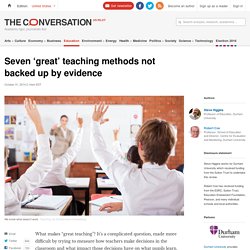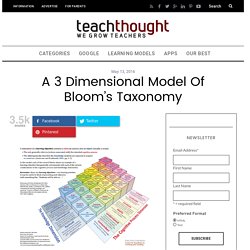

The Same… or Different? – Thinking Mathematically. For many math teachers, the single most difficult issue they face on a daily basis is how to meet the needs of so many students that vary greatly in terms of what they currently know, what they can do, their motivation, their personalities… While there are many strategies to help here, most of the strategies used seem to lean in one of two directions: Build knowledge together as a group; orProvide individualized instruction based on where students currently are Let’s take a closer look at each of these beliefs: Those that believe the answer is providing all students with same tasks and experiences often do so because of their focus on their curriculum standards.

They believe the teacher’s role is to provide their students with tasks and experiences that will help all of their students learn the material. On the other hand, others believe that the best answer is individualized instruction. Differentiated instruction is different than this. Think about Writing for a moment. Why Instructional Design Must Focus on Learning Outcomes, Not Learning Activities.
It’s no secret that kids learn better when teachers provide learning activities that keep them engaged. Teachers work tirelessly to plan engaging lessons that capture and keep the interests of their students, thereby making content more accessible. However, teachers continue to feel the daunting pressure to compete for their students’ attention amidst the ever-evolving and rapidly-hanging mass media, social media, and entertainment industry, as these elements do a stellar job of keeping students highly engaged outside of the classroom. Seven 'great' teaching methods not backed up by evidence. What makes “great teaching”?

It’s a complicated question, made more difficult by trying to measure how teachers make decisions in the classroom and what impact those decisions have on what pupils learn.
A 3 Dimensional Model Of Bloom's Taxonomy - A 3-Dimensional Model Of Bloom’s Taxonomy by TeachThought Staff Well, technically it’s a 2-dimensional representation of a 3-dimensional model, but being limited as we are in 2016 to 2D screens, it is what it is.

(Soon you’ll be able to 3D print what you see–download the plans and print it. Or play with it in virtual reality. Eventually a hologram you can manipulate digitally–pass around the room like a tennis ball, then fling it into the ether….) Rex Heer at Iowa State University, who created the graphic, explains: Teaching Students Philosophy Will Improve Their Academic Performance, Shows Study. There are many attempts to improve student performance which result in a host of measures, ranging from misguided to inspired.

Such efforts include not assigning students homework, recalibrating standardized tests to account for unfair background advantages, or subjecting students to the hard-to-fathom Common Core standards. But a recent endeavor in the UK found another solution which actually appeared to have worked - the students were taught philosophy! A study published last year demonstrated that 9 to 10 year olds, who took part in a year-long series of philosophy-oriented lessons, showed significant improvement in scores over their peers in a control group. The study involved over 3000 children in 48 primary schools all around England. The kids who were taking philosophy classes improved their math and reading skills by about two months of additional progress compared to the students who didn't take the classes. A Diagram Of Pedagogy in the 21st Century - TeachThought: A Diagram Of Pedagogy in the 21st Century by Terry Heick We know that thinking in the 21st century seems different.

What about teaching? The 5Ds framework for integrating technology in the classroom. Francis Jim Tuscano is a Grade 6 teacher and technology integrator advocate at Xavier School, San Juan City, Philippines.

He teaches Religious Education in the Catholic school, while co-heading the 1:1 iPad program committee. Jim is also a Book Creator Ambassador and ADE. As a teacher, I have always believed that students are capable of creating meaningful and wonderful products that demonstrate their learning and reflections in the classroom. Kids have this natural gift of curiosity and creativity that drives them to become creators. The Purpose of Online Discussion - Hybrid Pedagogy. Are online discussions really discussions?

I’ve been wondering this since I started teaching online. Many of my students, friends, and colleagues get a sour look on their face when it comes to discussion online, whether it be synchronous or asynchronous. They express, sometimes implicitly and others explicitly, a common sentiment that online discussion is not as good as the real thing, implying that — like the initial question asks — online discussion is not really discussion. Hybrid Pedagogy authors and participants have also taken up this question. Lesson Plans will be Platforms - 21st Century Planning.
I spent last week at ISTE and realize that there is a lot of talk about mindset, use of technology, student choice, creation, and a million other ideas all speaking to how we should think.

I struggled to find a lot of examples of what we should do. Edubabble got in the way of steps to design lessons, which is what teachers, coaches, and admins really need. This past year in Colonial with "Power of WE" meaning, admins, teachers, district office personnel, and Shawn Smith from Modern Teacher spent 4 separate days doing instructional rounds with a focus on tasks and how we can improve planning/feedback to make the classroom an environment that is centered on time, place, path, and pace. Shifting From Pedagogy To Heutagogy In Education. The Definition Of Heutagogy & Self-Determined Learning by Stewart Hase and Chris Kenyon Ed note: This is part 1 in a series on self-determined learning from Stewart Hase and Chris Kenyon.

Stewart’s site, Heutagogy Community of Practice, is a useful resource for reading on Self-Determined Learning. 3 Growing HR Trends Training Managers Can’t Ignore. This article by Doug Howard in Training Industry Magazine aptly sums up the hot trends that have dominated the HR industry this year.

We believe that some of these trends should also be picked up and implemented by learning and development professionals next year too. After all, we design for employees; it helps if we know what motivates them to perform better at the workplace and how we can keep them hooked to the courses that training managers and the C-suite commission spend thousands of dollars on to create.
Here are 3 growing HR trends training managers and L&D professionals can't ignore next year. Pedagogy, Technology, and the Example of Open Educational Resources. Key Takeaways When no meaningful relationship exists between an educational technology and pedagogy, the tool itself loses value. We should start with a vision for our courses and curricula, and then identify the technologies or strategies that can help us achieve or further develop that vision. Open educational resources provide a relevant example of how pedagogy can point toward a richer way to integrate technology into our courses and our teaching philosophies, shifting to a student-centered approach to learning. A few months ago, we gave a presentation where we poked fun at the educational technology industry's obsession with shiny new tools by suggesting that in addition to the learning management system (Canvas, Moodle, Blackboard), we'd soon be trying to find ways to use the cutting-edge technology of drones in our classrooms simply because they exist.
Faculty and administrators need to remember the motivations driving the adoption of technology in the classroom. Don’t panic: A guide to the art of effective questioning. Chances are, you’ve read, listened to or seen a version of A Hitchhiker’s Guide to the Galaxy. Here, teacher and author Lisa Jane Ashes applies themes and characters from Douglas Adams’ sci fi classic to look at how teachers can best create great questions. Why 42? Douglas Adams’ classic The Hitchhiker's Guide to the Galaxy is a great demonstration of how questioning can open up the imagination. What is Culturally Responsive Pedagogy? The growing popularity of culturally responsive instruction is slowly causing traditional trends to be reversed, with the onus to adapt to the demands of the multicultural classroom being increasingly placed on the teacher.
Given the wealth of diversity in our nation’s public schools, it is no wonder that instructional theory is advocating a shift toward a pedagogy that emphasizes a comfortable and academically enriching environment for students of all ethnicities, races, beliefs, and creeds. Culturally responsive pedagogy is a student-centered approach to teaching in which the students’ unique cultural strengths are identified and nurtured to promote student achievement and a sense of well-being about the student’s cultural place in the world. Culturally responsive pedagogy is divided into three functional dimensions: the institutional dimension, the personal dimension, and the instructional dimension. Fortunately, initial cultural biases can be overcome via hard work and reflection. 5 Teaching Practices I'm Kicking to the Curb. Critical Pedagogy: Being the Other. Is It Time to Give Up on Computers in Schools? Let’s not use 21st century technology with 19th century pedagogy. Technology may be changing but classrooms and teaching methods are pretty much unchanged since this picture was taken (Creative Commons image) By Larry Magid.
Professional Development in Digital Pedagogy. This July we are launching Digital Pedagogy Lab Courses, a series of professional development opportunities for educators, librarians, technologists, and instructional designers. 'Why teachers should become consumers of curricula and lessons planned and designed by others' “Teachers should be the consumers of curricula, not their designers.” So writes Professor Siegfried Engelmann, creator of the direct instruction method for teaching reading and maths, in War Against the Schools’ Academic Child Abuse. A Pedagogical Model for Excellence & Growth.
UbD-in-a-Nutshell.pdf. Reflecting On These “Crippling Behaviours” As A Teacher. As the Winter Break comes to an end, I can’t help but think of an article that I read earlier on during the holiday that’s been on my mind ever since. A Critical Analysis Of Learning Styles and Pedagogy In Post-16 Learning. Abstract In the adult education field there exist many educational and instructional theories to guide and help educators to provide appropriate education to their students’ needs, and within all the theories, one can find several referring to learning styles.